As a kid, I never gave a second thought to popping some fresh snow in my mouth when I was out playing in the winter wonderland and a lot of my friends did the same.
Sledding, constructing snowman, digging tunnels, and having snowball fights was hard work and a handful of snow helped to quench the thirst.
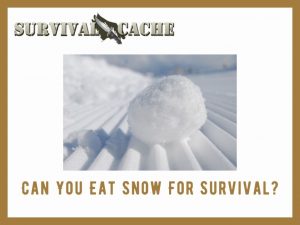
Using my childhood example and the fact that people eat slushes, ice, or snow cones it is no wonder that the idea of eating snow in a survival situation would seem like an okay thing to do.
Eating snow in a survival situation has been a topic of discussion and a big faux pas for a long time. If it is bad to do then why and how is it any different than the above examples?
When it comes to the right and wrong of consuming snow for hydration purposes, there is one main difference that needs to be considered and that is eating snow versus melting it to drink.
For many people, including myself growing up, this can be a slightly confusing topic so let’s use our critical thinking skills and start breaking down why eating snow is not a good idea.
SKIP AHEAD
Breakdown of Eating Snow
Most of our body is made up of water and we lose it all of the time through bodily processes like breathing, sweating, and waste removal, i.e. going to the bathroom.
Therefore staying hydrated is one of the most important things we can do to keep ourselves functioning properly.
But in a survival situation, drinking enough water can be a tricky proposition. In cold environments, a person surrounded by snow is like a person lost at sea. There is water all around, but it cannot necessarily be consumed directly.
Does Eating Snow Hydrate or Dehydrate You?
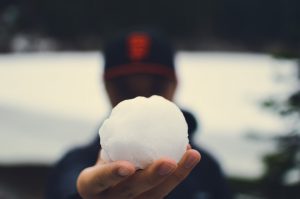
Since snow is basically frozen water, eating it should hydrate you right? As crazy as it may sound, eating snow as the only form of water intake will dehydrate the body.
This is due to the composition of snow.
First, there is not that much water content in snow as it is frozen water vapor surrounded by a lot of air. So snow is mainly air with some water in it.
Secondly, the snow is obviously very cold. Your body is constantly working to maintain a proper temperature. It needs to stay warm but not too warm and a drop of a few degrees in your body’s temperature can result in hypothermia.
This is why in cold conditions the body goes into overdrive by using energy to stay warm. By eating cold snow, the body needs to work even harder to maintain that warm temperature and it uses water during that process. More water will be used in that process than will be gained from the snow that was eaten.
Dangers of Eating Snow
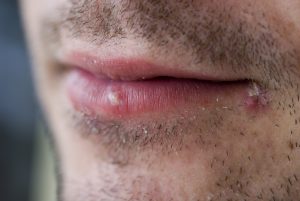
Most people look at snow as nothing more than pure frozen water. But snow is actually quite good at absorbing materials that we might not think about which can change its color.
For instance, it can absorb particulates from the air as it falls or from the ground once it has fallen. Not to mention the famous yellow snow created by animals passing by. While white snow is considered the safest to consume it is by no means a guarantee of cleanliness.
Eating a tiny bit of snow here and there generally is not going to hurt you but eating large quantities of snow can lead to:
- Sores on the lips
- Sores on the inside of the mouth
- Dehydration
- Hypothermia
- Becoming ill from tainted snow.
And this is where the problem of eating snow in a survival situation rests. The amount of water your body requires can only be obtained from eating more snow than you can safely consume.
Can You Melt Snow and Drink It?
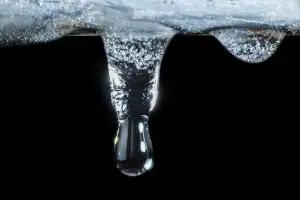
Absolutely! In fact, melting it is the proper way of hydrating yourself when snow is the only water source available.
Melting snow takes it from its solid frozen state, which your body cannot use, and turns it into liquid water which your body can use.
The best way to do this is by using a metal container to melt the snow over a heat source and then bring it to a boil.
When collecting snow to melt, it is best to use white snow that is not discolored. Discoloration can be an indication of contamination from bacteria or other harmful materials that you do not want to consume. But again just because it is white does not guarantee that it is safe.
Probably the safest bet is to scrape away the top layer of snow and collect some from the middle while avoiding snow that is in contact with the ground.
If you are melting several batches of snow in a row, leave some of the warm water from the previous batch in the cup or pot that is being used. When adding more snow, this warm water will help to speed the melting process along.
Snow should be treated like any other water source and after it is melted, it should be boiled long enough to kill anything harmful that could be residing in it.
Melting Snow Without Fire
Whether you are on the go or taking a much-needed rest, there is a way that you can begin melting snow without fire.
This works best with a water bottle or some small container with a lid. Simply fill a water bottle with snow, tighten the lid, and stick the bottle underneath your coat. Because this method is utilizes your body heat to warm the bottle, it will take longer to melt the snow.
Make sure that the water bottle is between two clothing layers. Avoid placing the bottle directly against your skin as this can lead to lowering your body temperature as well as damaging skin.
If You Must Eat Snow
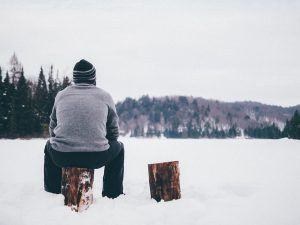
I hate to harp on this but eating snow should be avoided. This means grabbing a handful of snow and swallowing it is not a great idea.
However, here is the last resort option for consuming snow without fire or a container. Grab a small amount of snow and place it in your mouth. Do not swallow the snow but allow it to warm up in your mouth and swallow the melted water. This should be done sparingly and only if you have no other means of hydration.
Wrapping it up
Who knew the idea of eating snow could be somewhat complicated? But I hope that this article cleared up some of the mysteries about eating snow in a survival situation. Remember to always carry a water container and a way of making fire. This will allow you to melt snow and stay hydrated no matter where you are. Thanks for reading and stay prepared!

